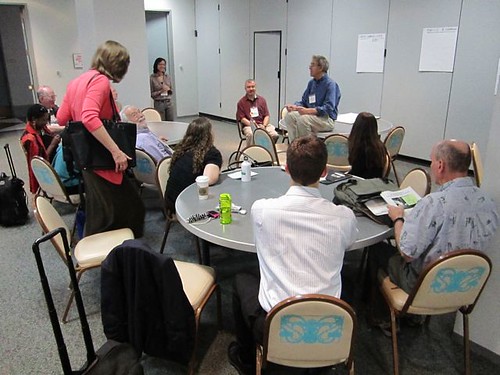 |
| Day Two of "Developing New Community Ideas" |
“The idea is simple. Create a list of community members that have something to share. Then share them. Exchanging special skills, yard work, cooking, pet and child sitting, other things, could really transform the social dynamics in a neighborhood.”
There were many great ideas, but it’s easy to see why this idea gained so much traction. It’s simple, local in application but global in potential reach, and is perfectly aligned with CP values such as fostering sense of community. On Day Two we were faced with a tall order and a shorter time frame than we’d worked with previously. We had 45 minutes to discuss (1) how to transform this idea into a reality, and (2) how community psychologists, and particularly SCRA members, can share and advance good ideas in the future.
We came up with a general outline for how to push this idea forward and used it to come up with a formula of sorts for implementing great new ideas:
Step 1: Find someone in community who cares – spearhead/champion.
Step 2: Do background research. Look at previous models. Look at literature.
Step 3: Get the word out and gain further support.
Step 4: Work with existing systems - get buy-in.
Step 5: Set up infrastructure (sustainability).
Step 6: Create step by step instructions so it can be replicated.
In order to push forward this particular idea, we agreed that it needed more specifics than we could deliver in the time frame, and it needed an owner so that collective responsibility did not translate into inactivity. Vincent agreed to be the owner, and three others agreed to assist him in writing up the next steps.
Along the way, we had great conversations about barter economies; high- and low-tech tools for sharing skills; and the importance of using a platform like this to support, rather than supplant, people trying to make a living with their skills. The SCRA community mini-grant was also suggested as a means to assist with start-up costs for this project.
As far as pushing forward good ideas in the future, we came up with the idea to have an annual New Community Ideas Initiative, that would award and fund great ideas. Two attendees took on the task of writing up a description of the Initiative, while the manager of the Community Toolbox volunteered to help with dissemination.
Of course, there are plenty of ways to share great ideas online (e.g. SCRA wiki, Changethinkers, ), and we’ve yet to make decisions. We’d love to hear what you have to say – how do you share ideas? What do you think of the Neighborhood Skills Exchange? Do you already have something like this in your neighborhood? Would you want to implement one?
